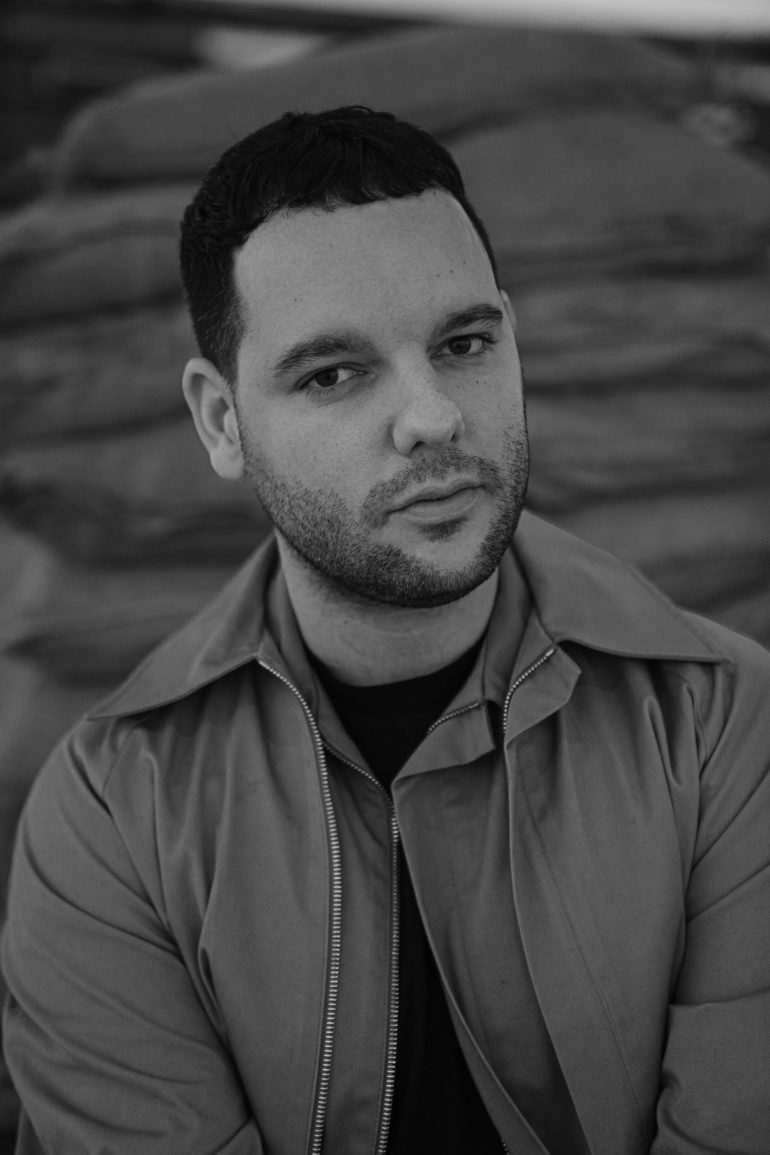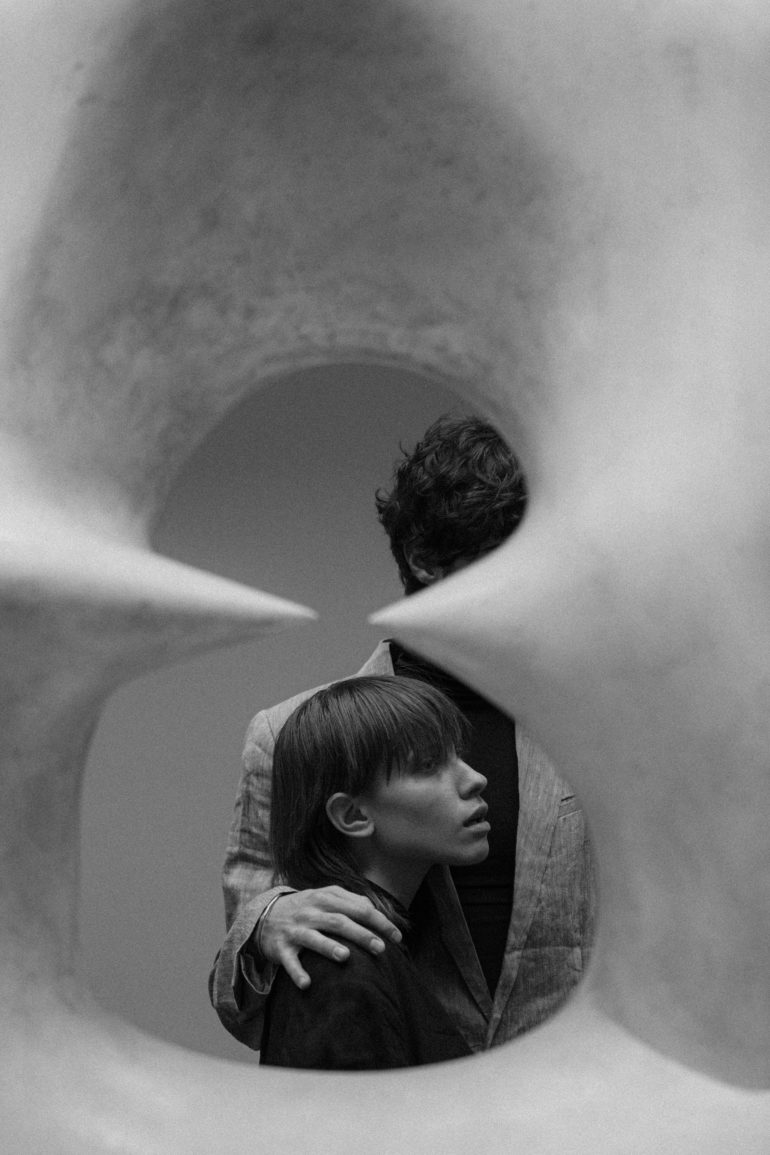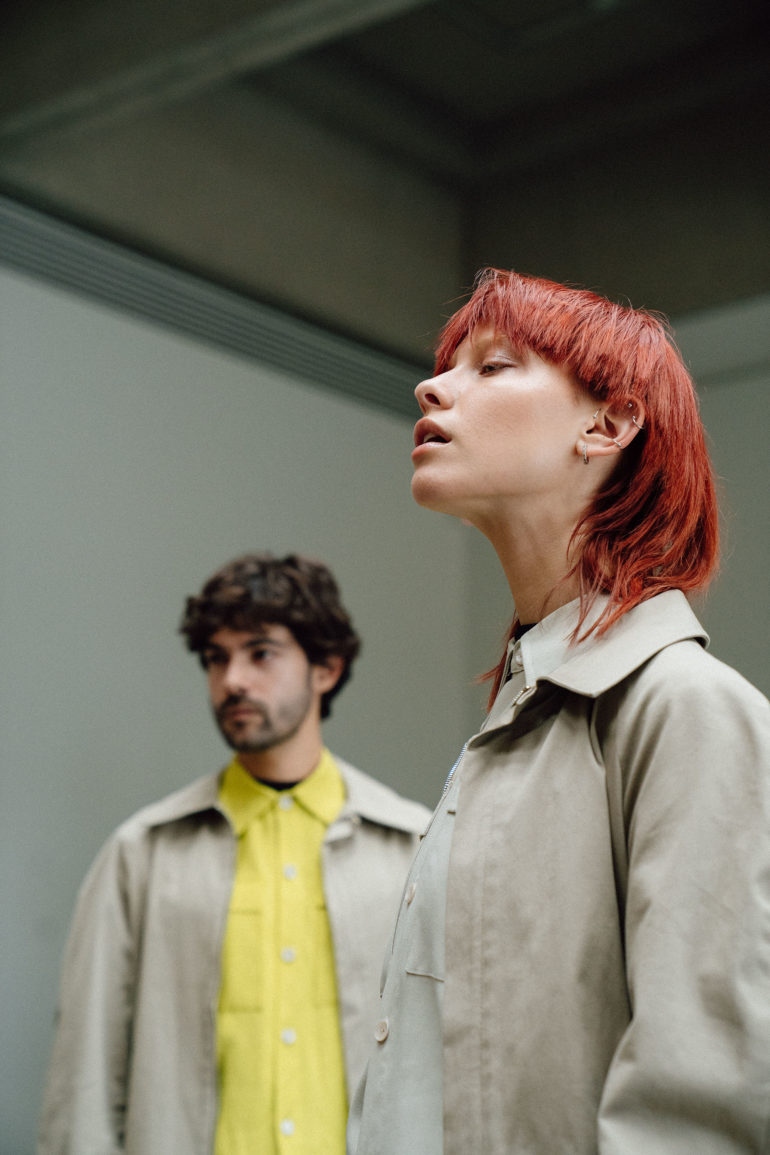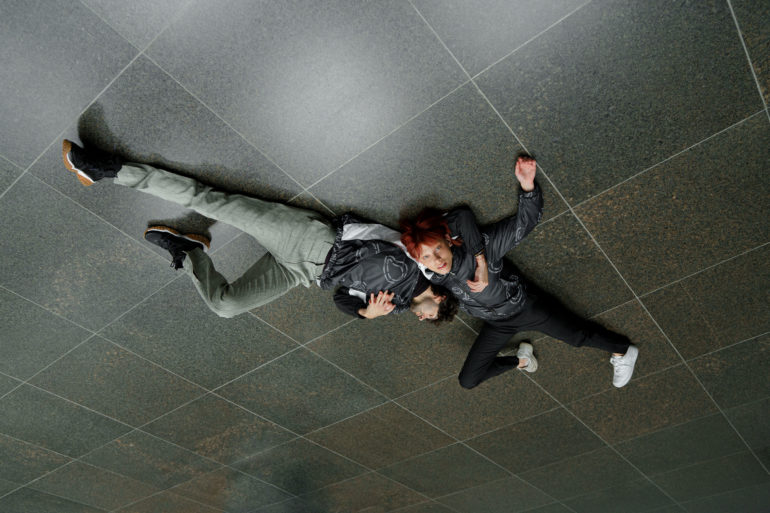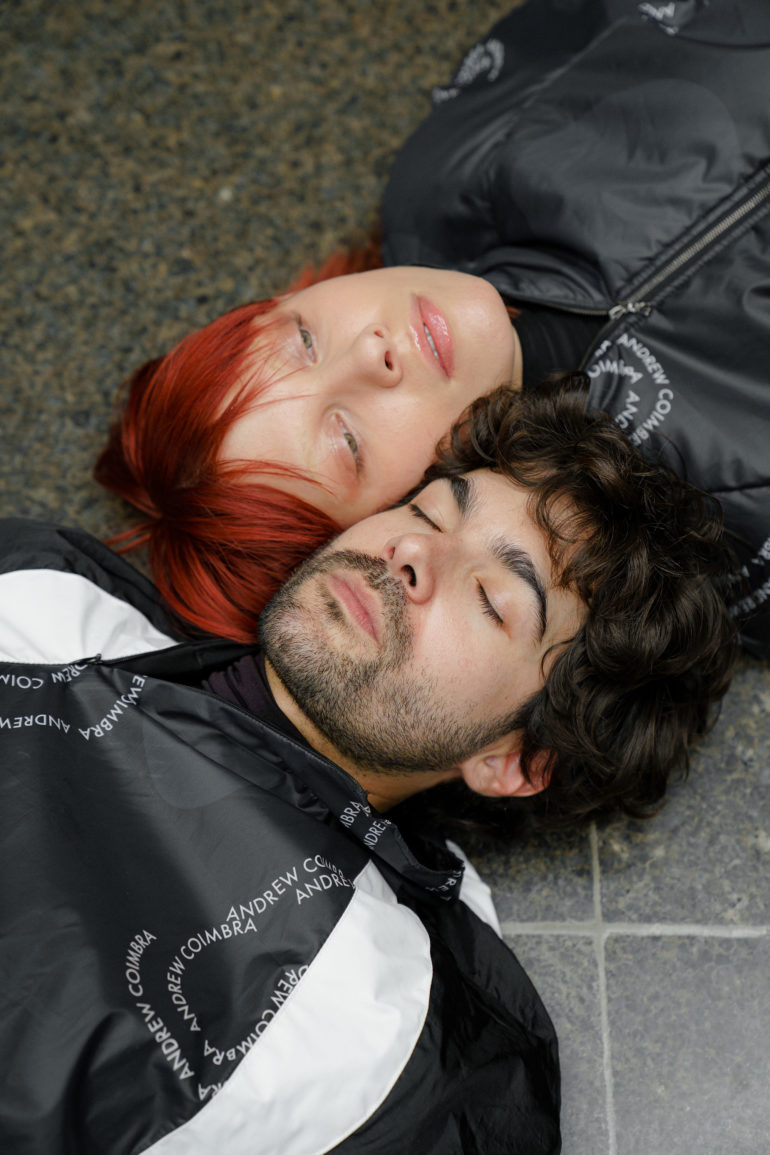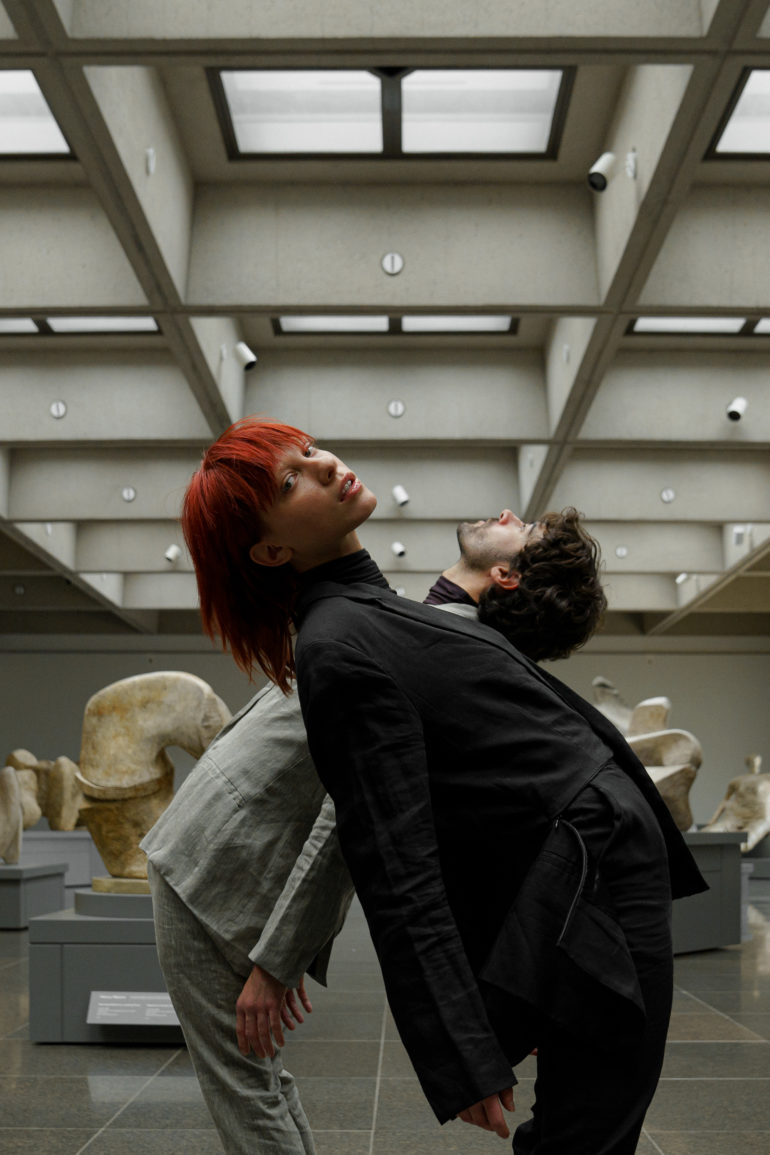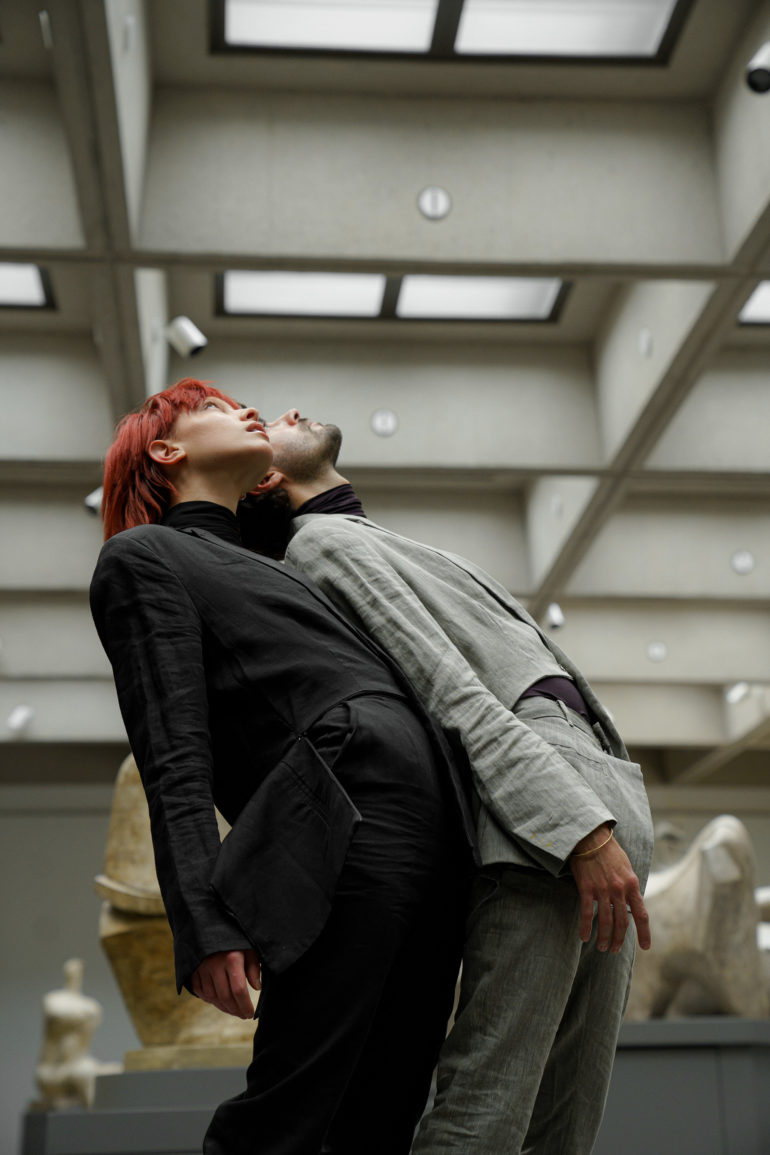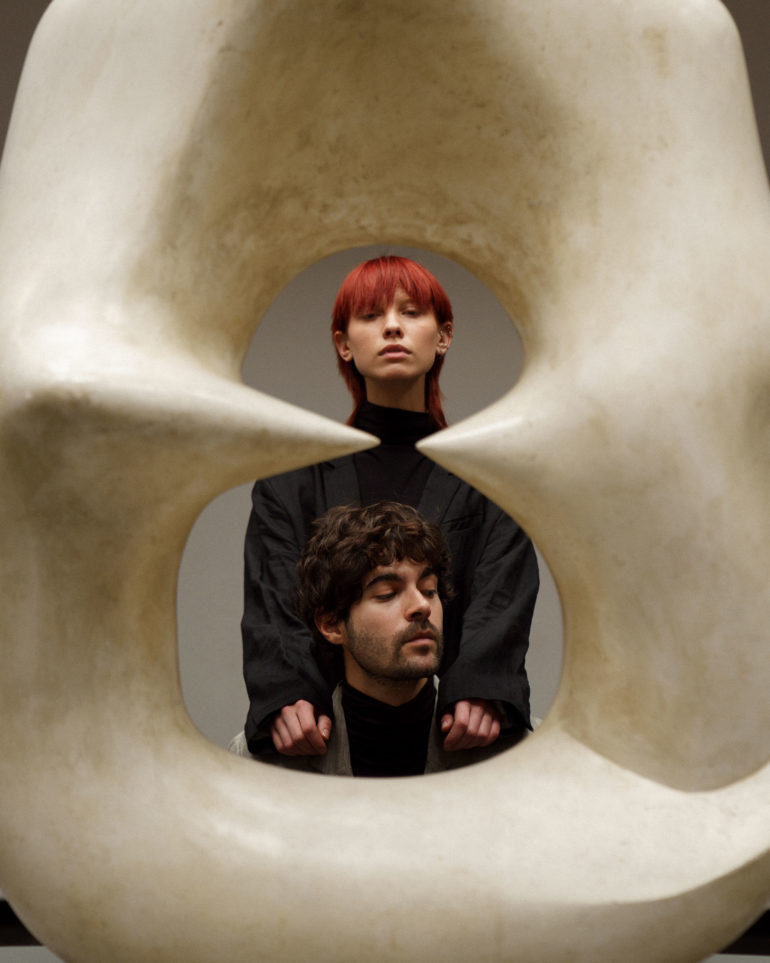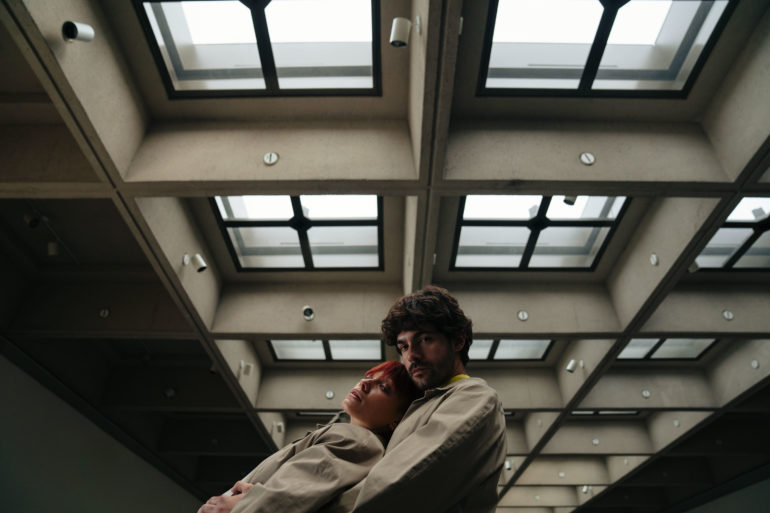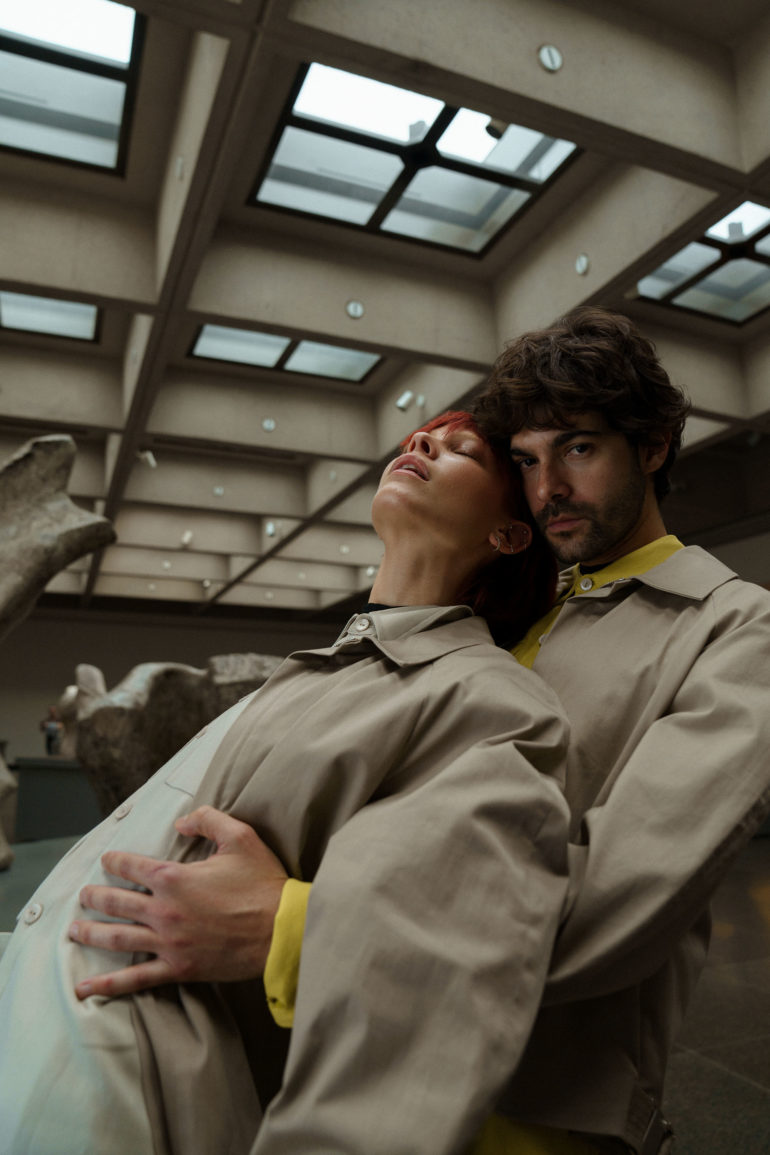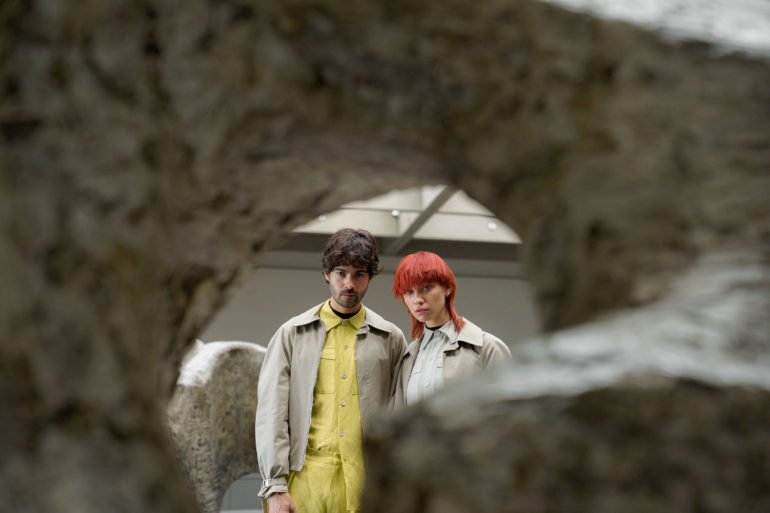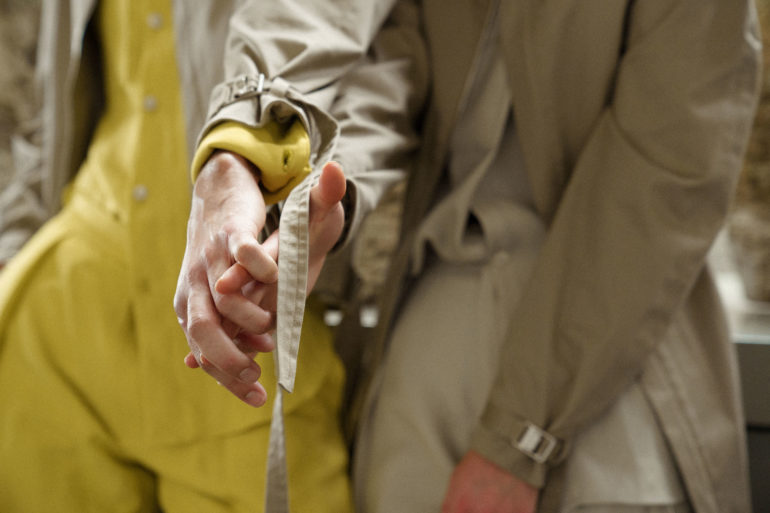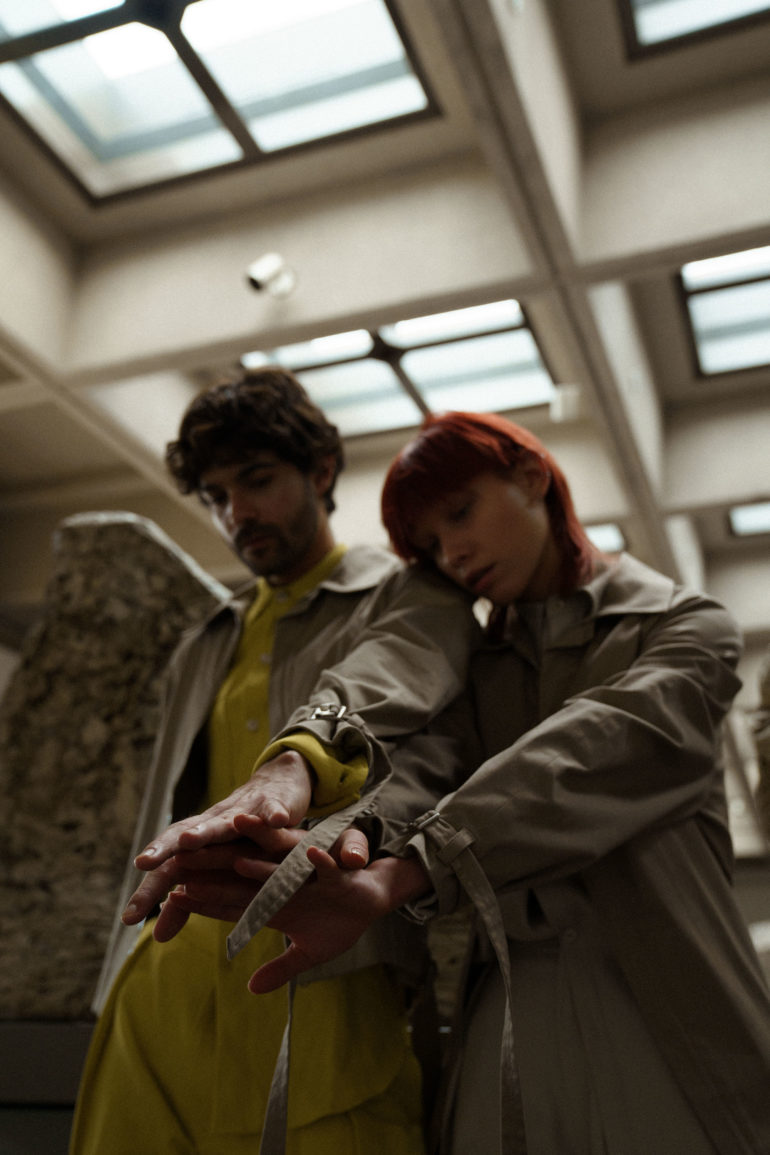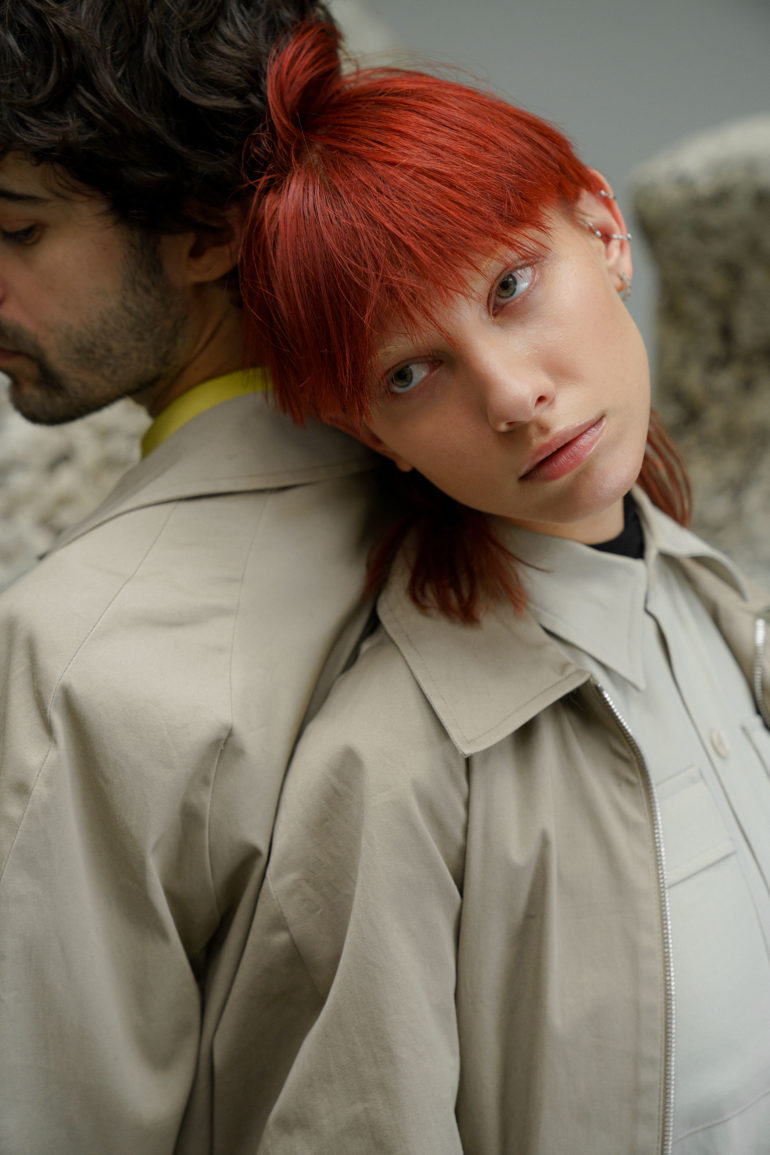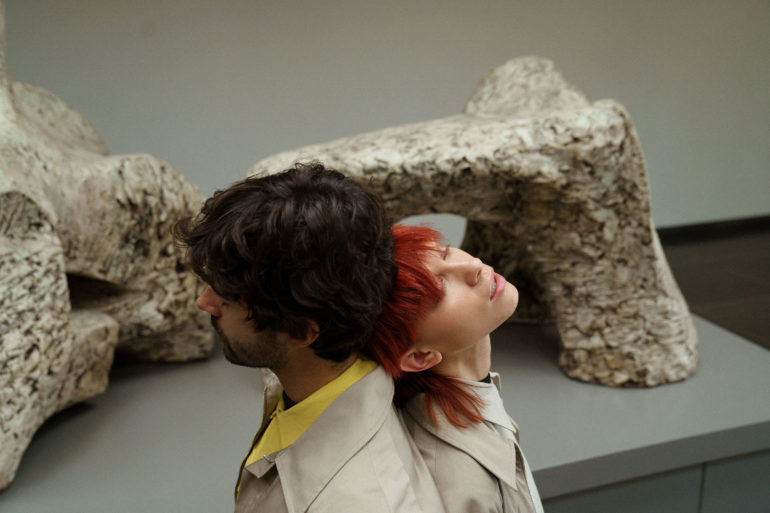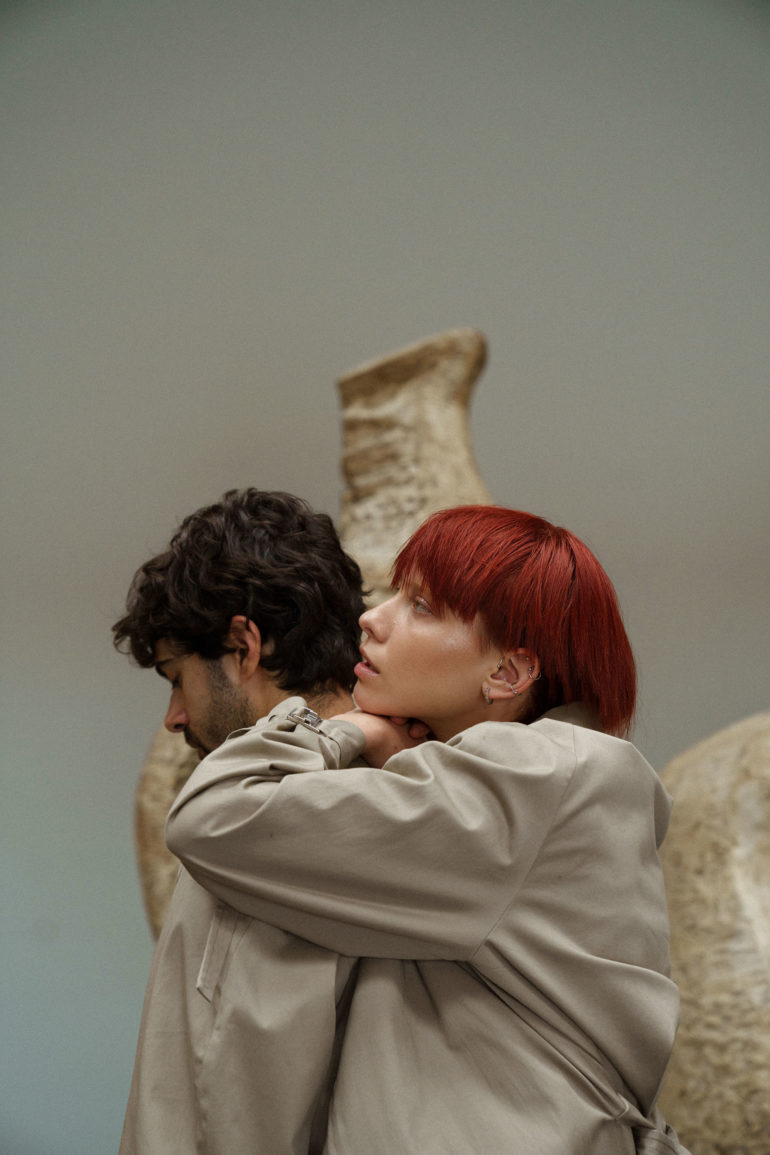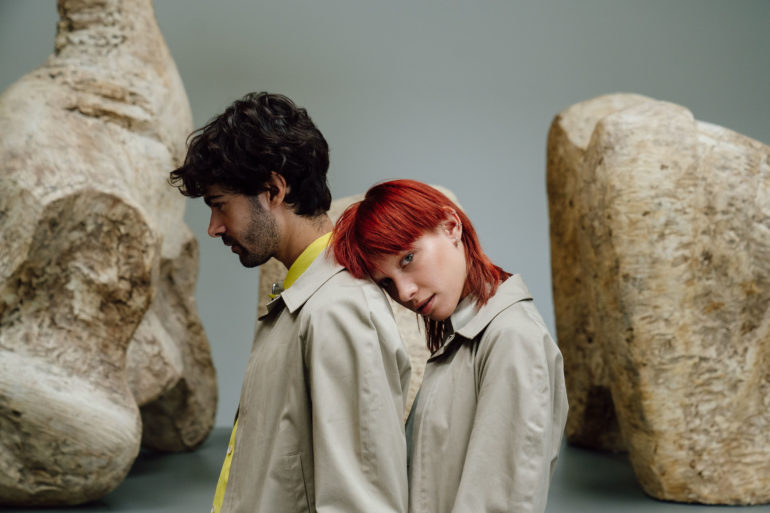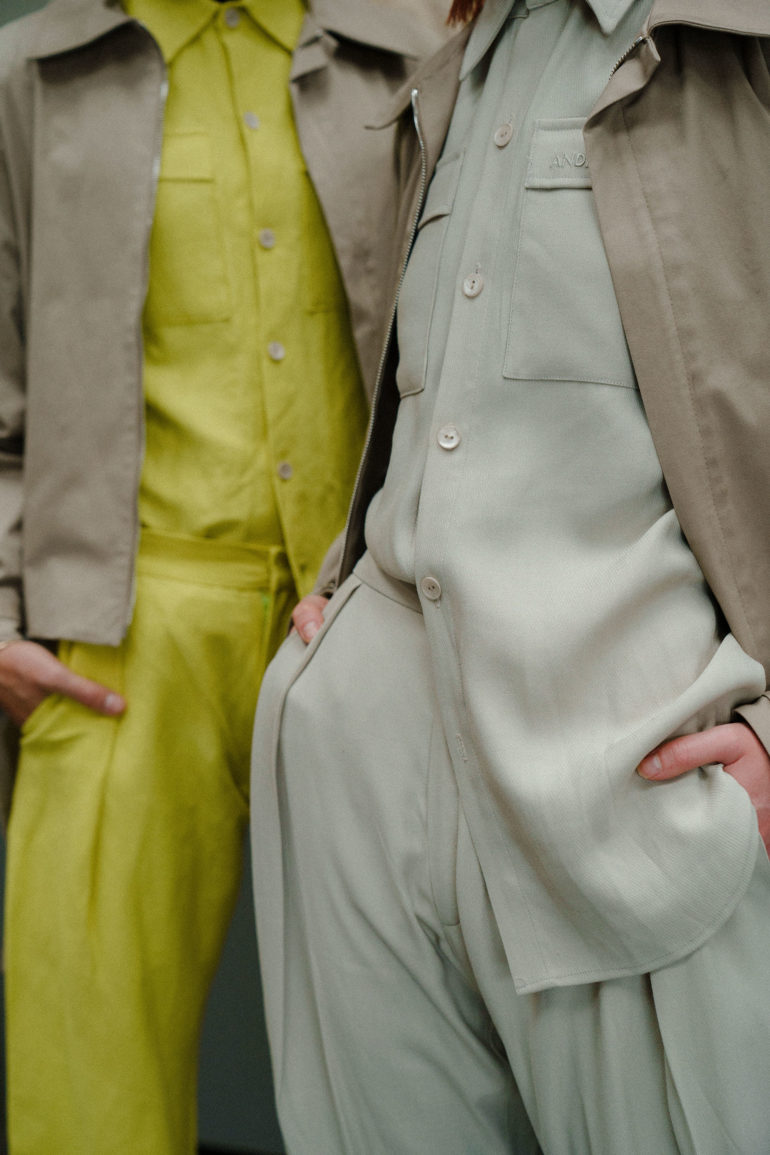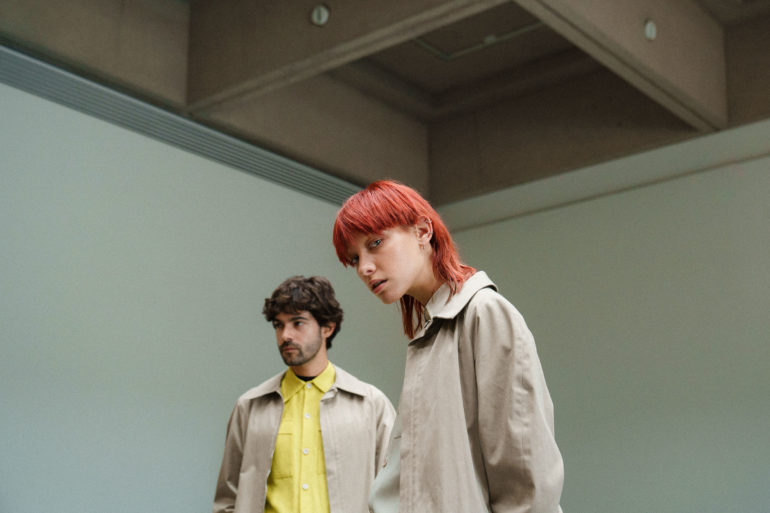My emailed request to photograph and interview Andrew Coimbra was received with an enthusiastic yes. As he swiped through Noah’s instagram feed, we began establishing the groundwork for the shoot; Andrew would bring two models to the AGO where we would photograph some pieces from his S/S 2020 collection. Soon after our call, he created a mood board based off of what he envisioned would work with Noah’s style so that we could all catch the vibe. I was impressed.
We scheduled the shoot and arranged to meet at the AGO on a Sunday morning—there would be less traffic. The plan was in place—Andrew would take the models to change and meet us at the Henry Moore sculpture exhibit on the second floor. After a short wait, the trio appeared—models dressed and Andrew wearing multiple layers of jackets which would be needed for the wardrobe changes.
While the models interacted with the camera, Andrew stood back and watched, being mindful not to interfere, aside from the occasional suggestion. He was keen on having Noah and models’ Nina and Christian interpret his pieces without interference. The photoshoot was over within an hour and aside from an encounter with an overzealous security guard, everything went well.
While the models changed into their own clothes, Andrew, Noah and I chatted and decided to go back in to visit Yayoi Kusama’s Infinity Mirror Room when I realized we hadn’t taken a photo of Andrew. He agreed to a few quick shots which Noah snapped before he hugged us and left us to see the Early Rubens exhibit.
I enjoyed the simplicity and honesty of this man and was looking forward to finding out a little bit more about the designer and his creative process.
Luso Life: Tell us about Andrew Coimbra—the man and the brand.
Andrew Coimbra: I’m a 32-year-old (!), Toronto-born and currently Toronto-based designer. My eponymous label began as a genderless line, but has since evolved to include a womenswear range.
LL: What sparked your interest in fashion?
AC: I was always creative; I started by drawing and painting as a child and all of my teachers and family members encouraged me to keep developing and growing my skills. I think around the age of 12 I became fascinated with music videos and how pop culture could really influence style. My Avó sewed at home casually and she actually taught me how to use the machine and some basic pattern design techniques.
LL: Your father owns a family-run recycling business. Stereotypically, this wouldn’t be the environment where a future fashion designer is bred. Do you think this background affected your approach to design?
AC: I think the influence our family business has had on my venture has more of an effect in the realm of business management rather than an approach to design. I think my approach to design has been informed by other life experiences; my affinity to art, pop culture, and I would argue the more sensitive/meaningful relationships I’ve been lucky to have with friends and members of my family.
LL: Was your family supportive of your career choice?
AC: They were and are! In the beginning I think the support for my creative background was in assumption that I would go into architecture or something more familiar to them, business-wise. But as I pushed more toward my own goals it was easier for my family to see a parallel in the way my industry works.
LL: How has your work evolved since you started the label?
AC: Originally I intended on making it a menswear label, simply because that’s where my interests were, but as stylists started to borrow pieces for photoshoots and put them on female-identifying models, I was reminded of how fluid my own wardrobe (women’s jackets, jeans etc.) is and so making it genderless became more important.
After a couple of seasons I decided to add a womenswear capsule with pieces that are traditionally worn by women (dresses, skirts etc.) to help bridge the genderless pieces. The capsule has been well received and as of Spring 2020 the womenswear collection is its own entity.
LL: Running your own label obviously comes with a lot of personal sacrifice and some amount of fear. Was it difficult for you to make the leap?
AC: It was – and still is – challenging only because of things like time management, finances, etc. It’s a constant juggling act, which is both tricky and fun. Once I dove in I found a rhythm that works for me.
LL: What is the biggest lesson that you have learned since you started your company?
AC: Time is important. Not just your own time; the time of others; half of the challenge is managing and coordinating things, the other half is making sure to accomplish them or have them accomplished in an efficient manner that doesn’t rob people of the time they are investing in you/your projects.
That, and having a support system to give you life.
LL: Do you have plans to open your own storefront?
AC: It would be a dream, but I think establishing my name first in order to make the potential storefront a destination is the priority.
LL: Do you typically design pieces with your yourself in mind?
AC: Yes I do. I like to design pieces that I’d wear, but more specifically that I can see being enjoyed for a long time, not just a fleeting moment to appease a trend.
LL: I find it interesting the way you’ve chosen to divide your collection—“women” which falls into a societal gender construct and “genderless”. If you’re drawing a line, how do you decide? Explain your approach to the genderless category?
AC: Both collections have been evolutionary. The genderless category started after stylists began borrowing pieces for womenswear-geared projects and putting them on female models. It struck me as such a silly thing for me to have denied as being an option since I wear pieces from the womenswear section of stores all the time. I had always developed the collection with the idea of not confirming to a stereotypical menswear aesthetic, so deciding to take it a step further and redefining it as Genderless felt second nature.
Since the label already had a menswear-leaning edge, I wanted to establish pieces that felt more specifically ‘womenswear’ that would help bridge the pieces, and illustrate to buyers and the audience how truly versatile the core collection is. From a business perspective, it helps secure a wider market reach. From a creative perspective, it offered me a fun new challenge and outlet for my ideas.
LL: You come from a diverse cultural background. Your father is Portuguese, your mother is Irish and you grew up in Canada. How does culture influence you?
AC: I think the way the label had developed to have a duality in the gender flexibility is a mirror of the cultural duality I often feel I was raised with. Both sides of my family are so incredibly individual; their cuisine, first language (and accents—both in English and otherwise), style, aesthetic, and approach to their priorities are so different. With that said, their core values are very much aligned, and by both integrating with society in Canada, there is a unification in identity; a way to exist individually within a common theme.
I don’t know if there is a direct creative inspiration, but it certainly has influenced the way I orchestrate and market the brand – most specifically the Canadian new immigrant aspect. It’s incredibly important to me that the models I hire don’t reflect a homogenized ideal of something.
LL: I see you have the island of Santa Maria, Azores in your logo. Does the physical geography of the island inspire your work in any way? Perhaps colour or textile choice? Are the designs connected to your heritage?
AC: That is a complete coincidence! My father and his family is from the north, bordering Spain, and I’ve never been to the Azores. I just really like amoebic shapes! I find them to be balanced and very much a repeating element in nature (as illustrated by Santa Maria)
LL: We’re proud to be debuting some pieces from your upcoming spring collection. Could you speak to the season’s direction?
AC: I’m excited that they’re being featured!
These pieces are from the Spring 2020 genderless collection, which is inspired by beach cities like Barcelona, Lisbon, etc., where there is this sort of balancing act of being part of an urban community and having the freedom to escape to a beach. There is a focus on the idea of an ‘urban uniform’ and subtly deconstructing it with detachable components that informalize things.
LL: You recently worked with Nico Paulo in Portugal, supplying most of the wardrobe for her latest video. Do you often take on projects like this? If so, do you vary your style according to the specific mood of the piece?
AC: I love collaborating with other artists—it’s what makes the industry so special and strong. It brings another perspective to the pieces I make, which is the point of them, in the end.
LL: Are any celebrities wearing Andrew Coimbra?
AC: Yes, a few! R&B singer Mya, Alessia Cara, OVO’s Majid Jordan and Charlotte Day Wilson (a favourite of mine), Amanda Brugel (The Handmaids Tale), and Ria Mae, among others.
LL: Is it still exciting to see your clothing walk by you on the street?
AC: It is! It’s also really nice to have people tag and share their outfits—it’s actually more exciting (most of the time) than a feature on a celebrity.
LL: Some artists purposely distance themselves from what their peers are producing. Do you allow yourself to indulge in the work of other fashion designers?
AC: I’m always inspired by art and pop culture, but lately I’ve been really into sculptures and textural works. I love the relationship between shape and texture and how easily transferable those ideas can move to fashion design by way of pattern development and fabric sourcing.
LL: Although I wouldn’t call your clothes trendy, are you driven by trends? Do they influence what you do at given time or perhaps serve as something to react to?
AC: I like to keep an eye on trends – mostly general silhouettes and colour trends just to make sure it’s not too far off the mark. Retail buyers usually follow trend reports when making their selections and it’s important to stay within the realm of what will sell for that season.
LL: What advice would you give young designers.
AC: I would say it’s important if you have the luxury to do so to intern somewhere at least once. It’s even better if you can do it in another country just to be able to harness that much more experience.
And to be sure to know what your individual style is as a designer, as a label and who that style appeals to.
LL: Is this a good time to be in fashion?
AC: I think with the gender fluidity movement becoming so much more of a forefront focus, it’s a great time to be in Fashion. Androgyny has always been there, but really identifying and establishing the idea of not feeling restricted by any particular identity has a lot of power and freedom.
LL: Instagram can sway how people perceive fashion. How has this acceleration in consumption affected the industry.
AC: In many ways it has fuelled the need for consumption, but more recently its fuelled the need for awareness around consumption, which I think was only a matter of time. It’s so easy to see how fleeting the interests are on social media platforms, and there is a certain richness to being able to enjoy pieces of your wardrobe more than once (again!) and also in different ways than you did before. The challenged has transferred from an unhealthy obsession with new, to the much more reasonable objective of making strong pieces look or feel new.
LL: With regards to fashion sense, do you feel a responsibility to educate the public.
AC: I think people have their own unique styles and I design with the intention of allowing the pieces to be adopted into the wardrobes of a stranger. The idea of imposing an image onto someone feels unnatural to me.
All I can do as a designer is establish a feeling for my label, and hope that it resonates with people on an individual and meaningful level.
LL: Are there any current designers that inspire you?
AC: The designers I’m inspired (aesthetically) by are Ann Demeulemeester and Damir Doma. Neither of them are reflected in my work but I think their work is incredible. And, of course, Alexander Wang for the business achievements.
LL: What’s your thoughts about companies like H&M and Zara copying what they see on the runway and putting them into mass-production?
AC: I hate it and I love it. There is such a talent and skill in being able to recreate pieces especially in the time that these retailers do it, but there is also a complete lack of respect and respectability to it. Worst of all, there is a lack of art, which is the biggest issue because fashion is—at its core—art.
LL: What kind of hobbies do you have outside fashion?
AC: I love to read, and I’m obsessive about collecting new music and watching music videos.
I also really love watching documentaries and anything that feeds me with useless trivial knowledge. Jeopardy is one of the best game shows ever developed, FYI.
LL: On your website you have a page dedicated to DJs where you say, music is a huge part of your developmental process—what are you listening to right now?
AC: Yes! I looooved doing that series with DJs. It became a little bit too much of an effort to coordinate, and like I mentioned before my biggest concern in working with people is not wasting their time. It’s something I want to explore more in the future when I have the resources to accommodate it.
In terms of what I’m listening to right now, I’m very in Spanish pop singer Rosalia, Dawn Richard, Kali Uchis, Sufjan Stevens, and have been revisiting disco classics by Earth Wind & Fire, Kool & The Gang, Cheryl Lynn and A Taste of Honey. There’s also a Toronto-based DJ I’m really in love with and her name is Bambii.
WORDS: DAVID GANHAO
PHOTOS: NOAH GANHÃO

